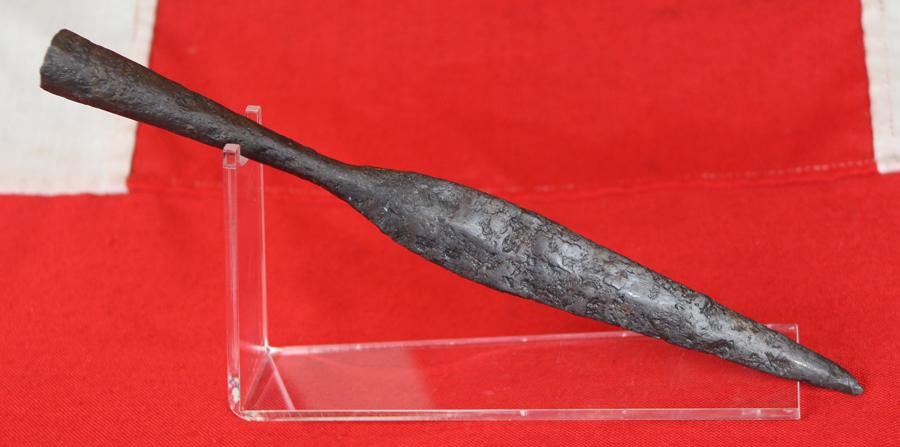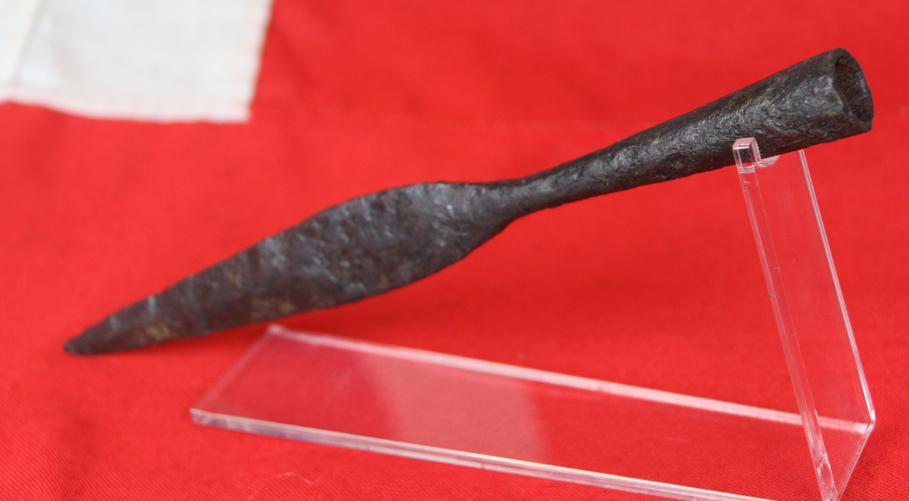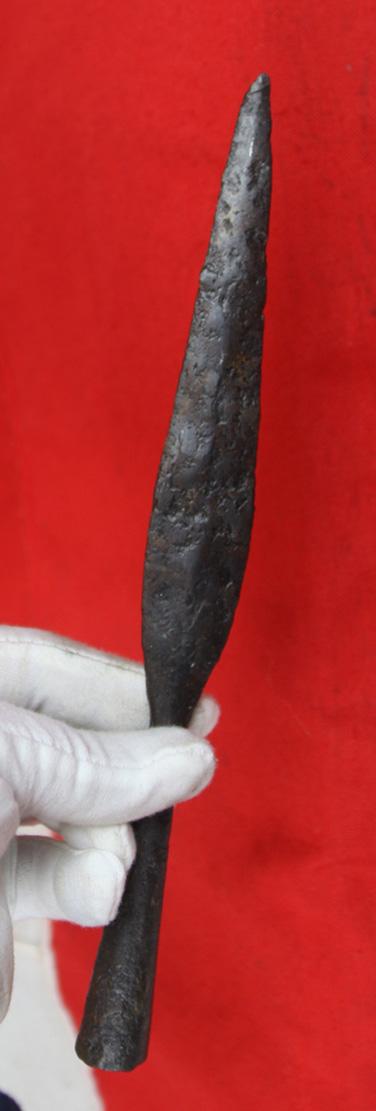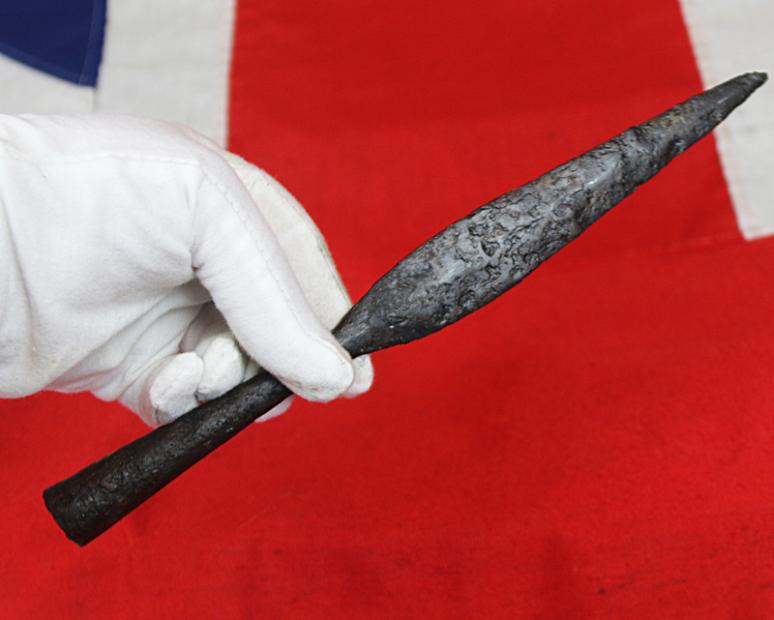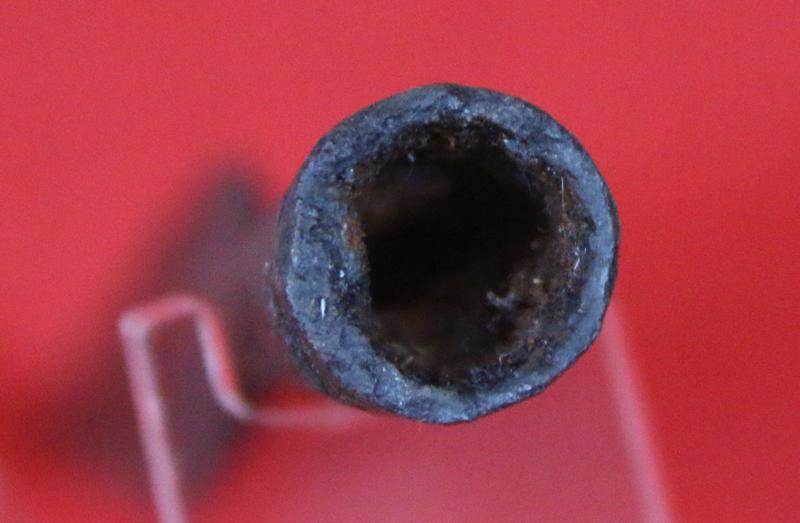Ancient Iron Viking Socket Spear. Circa 9th century, Around 1200 Years Old
Like several pieces we acquired often from a Grand Tour of the 1820’s, Viking pieces and artefacts, such as rings and spear heads, acquired in Northern France near Paris, that originated from around the time of the Viking siege of Paris in the early 800’s.
Many historians commonly associate the term "Viking" to the Scandinavian term vikingr, a word for "pirate." However, the term is meant to reference oversea expeditions, and was used as a verb by the Scandinavian people for when the men traditionally took time out of their summers to go "a Viking." While many would believe these expeditions entailed the raiding of monasteries and cities along the coast, many expeditions were actually with the goal of trade and enlisting as foreign mercenaries.
The Viking Age generally refers to the period from A.D. 800, a few years after the earliest recorded raid, until the 1050s, a few years before the Norman Conquest of England in 1066, according to Angelo Forte, Richard D. Oram and Frederik Pedersen, authors of "Viking Empires" (Cambridge University Press, 2005). During this time, the reach of the Scandinavian people extended to all corners of northern Europe, and many other nations found Vikings raiding their coasts. The farthest reported records of Vikings were in Baghdad for the trading of goods like fur, tusks and seal fat.
Spears in the Sagas
"Then Thorolf became so furious that he cast his shield on his back, and, grasping his spear with both hands, bounded forward dealing cut and thrust on either side. Men sprang away from him both ways, but he slew many."
- Egil's Saga, Chapter 53
"Gunnar clutches the spear with both hands, and turns on (Thorbrand) quickly and drives it through him, and hurls him down on the ground. Then up sprung Asbrand his brother. Gunnar thrusts at him with the spear, and he threw his shield before the blow, but the spear passed clean through the shield and broke both his arms, and down he fell from the wall."
- Njal's Saga, Chapter 76
"At this brunt Helgi, the son of Hardbien, rushed in with a spear, the head of which was an ell long, and the shaft bound with iron. When Bolli saw that he cast away his sword, and took his shield in both hands, and went towards the dairy door to meet Helgi. Helgi thrust at Bolli with the spear right through the shield and through him."
- The Laxdale Saga, Chapter 55
The spearheads were made of iron, and, like sword blades, were made using pattern welding techniques (described in the article on swords) during the early part of the Viking era . They could be decorated with inlays of precious metals or with scribed geometric patterns
After forming the head, the smith created the tang in the early period, such as for a javelin type spear, or in the later Viking mostly a socket fitting for a regular spear. Sometimes with holes for rivets to grip onto the haft.
However, there is little evidence that tells us the length of the shaft. The archaeological evidence is negligible, and the sagas are, for the most part, silent. Chapter 6 of Gísla saga tells of a spear so long-shafted that a man's outstretched arm could touch the rivet. The language used suggests that such a long shaft was uncommon.
Perhaps the best guess we can make is that the combined length of shaft and head of Viking age spears was 2 to 3m (7-10ft) long, although one can make arguments for the use of spears having both longer and shorter shafts. A strong, straight-grained wood such as ash was used. Many people think of the spear as a throwing weapon. One of the Norse myths tells the story of the first battle in the world, in which Odin, the highest of the gods, threw a spear over the heads of the opposing combatants as a prelude to the fight. The sagas say that spears were also thrown in this manner when men, rather than gods, fought. At the battle at Geirvör described in chapter 44 of Eyrbyggja saga, the saga author says that Steinþórr threw a spear over the heads of Snorri goði and his men for good luck, according to the old custom. More commonly, the spear was used as a thrusting weapon. The sagas tell us thrusting was the most common attack in melees and one-on-one fighting, and this capability was used to advantage in mass battles. In a mass battle, men lined up, shoulder to shoulder, with shields overlapping. After all the preliminaries, which included rock throwing, name calling, the trading of insults, and shouting a war cry (æpa heróp), the two lines advanced towards each other. When the lines met, the battle was begun. Behind the wall of shields, each line was well protected. Once a line was broken, and one side could pass through the line of the other side, the battle broke down into armed melees between small groups of men.
Before either line broke, while the two lines were going at each other hammer and tongs, the spear offered some real advantages. A fighter in the second rank could use his spear to reach over the heads of his comrades in the first rank and attack the opposing line. Konungs skuggsjá (King’s Mirror), a 13th century Norwegian manual for men of the king, says that in the battle line, a spear is more effective than two swords. In regards to surviving iron artefacts of the past two millennia, if Western ancient edged weapons were either lost, discarded or buried in the ground, and if the ground soil were made up of the right chemical composition, then some may survive exceptionally well. As with all our items it comes complete with our certificate of authenticity. overall 10.25 inches long
Code: 23709
545.00 GBP

